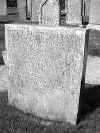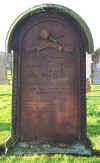|
Old
Mortality and his gravestones.
Robert Paterson was born ca 1713 on the farm of Haggis Ha,
in the parish of Hawick and as married man moved to the
village of Balmaclellan . A stonemason by trade and owner
of a small quarry, he spent most of his life touring the
lowlands of Scotland visiting and maintaining Covenanter
grave sites. His method of cutting or incising of letters
and the ability to get so much into a limited space makes
his work very distinctive. He gained some fame as
`Old Mortality, the character in the book of the same name
by Sir Walter Scott.
His
connection with Scott is said to have stemmed from a
Joseph Train who was the local excise supervisor in Newton
Stewart and something of a collector of anecdotes, tales
and traditions of the Covenanters. Train told Scott about
Robert Paterson Senior, and that (at that time ca 1816)
his son Robert , then aged about 70, was living in
Balmaclellan. The grandson of Paterson, the Rev
Nathaniel Paterson, minister at Galashiells, was a close
acquaintance of George Thomson, librarian to Sir Walter
Scott.
O.M.
married Elizabeth Gray, a cook and maid to Sir Thomas
Kirkpatrick of Closeburn. She used her contacts to secure
the lease of the freestone quarry at Gatelowbrigg, in the
parish of Morton. They moved there ca 1746. In subsequent
years Paterson became more and more involved in his
pursuit of Covenanter memorials and his wife often sent
the children to find him . Perhaps in desperation the
family moved to Balmaclellan in 1768.
 Paterson Paterson
and Scott actually met when he was on one of
his longer
journeys and cutting a headstone in Dunnottar
Churchyard. Sir Walter Scott was on a visit to
Dunnottar Castle and was collecting material for what
became the Waverley Novels, including “Old Mortality” and
“Tales of my Grandfather”.
The Fasti entry for James
Mitchell , minister at Dunnottar in 1772 tells us
” In the churchyard of
Dunnottar, and afterwards in the manse, in the autumn of 1793, Sir Walter
Scott met with Robert Paterson, who, twenty three years later, formed the
prototype of Old Mortality. “He and Mr Walker, the minister of the parish,
found the poor man refreshing the epitaphs on the tombs of certain
Cameronians who had fallen under the oppressions of James the Second’s
brief insanity. Being invited into the manse after dinner to take a glass
of whisky punch, he joined the
minister’s party but ‘was in bad humour,’ says Scott, ‘and had no freedom
for conversation.'”
Paterson
died 14 February 1801 and is buried at Bankhead

of Caerlaverock, A monument ,erected in 1869, reads:
Why seeks
he with unwearied toil
Through Death`s dim walks to urge his way;
Reclaim his long asserted spoil,
And lead oblivion into day ?
There are
several statues of Old Mortality including that by
John Corrie of him with
his faithful donkey at the
Dumfries Museum. Others are at the Newton Stewart
Museum and recently the statues at Balmaclellan have been
refurbished and displayed. Examples of his work are, of
course, mainly in churchyards although a precious few have
made their way into the local museums. Regrettably they
are sometimes the victims of the modern blight of vandals
and when broken are not always `saved` . The
stone for the Caldon Martyrs, six men caught at

a prayer meeting and executed on the spot in 1685, was
vandalised in 1983 but thankfully the broken stone was
taken to the Newton Stewart Museum for safe keeping. This
reversed image shows the inscription on the reverse which
reads
CORNET
JAMES DOUGLAS, AND
BY THEM MOST IMPIOUS
LY AND CRUELLY
MRTRED FOR THEIR
ADHERENCE TO SCOT
LANDS REFORMATION
COVENANTS NATIONAL
AND SOLEMN LEAGUE.
Recently
Sandy Pittendreigh of the Dumfries FHS came across
some old stones deep in the shrubbery of Dumfries Museum.
Amongst the ivy covered stones there
was also a hogsback cover to a possible Knight Templar`s
tomb with markings of a large sword on it, and another old
stone with the engraving of a primitive plough. The
museum were unaware of the importance of the stones which
it transpired were brought there by the local Parks
Department ca 1970.
Detective
work by Sandy established that they were from the Old St
Michael`s Church in Dumfries where there are several
Covenanter graves and the Robert Burns Memorial. The
present martyrs` memorial dating from 1837 is an imposing
light grey obelisk, and has around it some table
stones of the Dumfries martyrs William Grierson and
William Welsh. Another gravestone is that of James Kirko
or Kirka, who was shot on the Whitesands next the river
where a monument stands
today. These have the date 1873 inscribed round the edge
and the text very closely follows on the fragments that
have been found. These are clearly relatively modern
replacements for the damaged stones which were cast
aside and first recovered a hundred years later in a clean
up of the cemetery. Now, a further thirty or so years
later another opportunity is at hand to preserve the
historical carvings of Old Mortality. I hope the
opportunity will be taken this time.
The Kirko or
Kirka stones
The old and new stones of
William Welsh.
Seventeenth
century burials,
Gravestones and memorials.
|